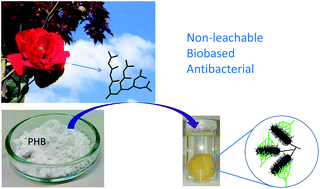当前位置:
X-MOL 学术
›
Green Chem.
›
论文详情
Our official English website, www.x-mol.net, welcomes your
feedback! (Note: you will need to create a separate account there.)
New biobased non-ionic hyperbranched polymers as environmentally friendly antibacterial additives for biopolymers
Green Chemistry ( IF 9.3 ) Pub Date : 2018-02-01 00:00:00 , DOI: 10.1039/c7gc03401f Carlos R. Arza 1, 2, 3, 4 , Sedef İlk 5, 6, 7, 8 , Deniz Demircan 1, 2, 3, 4 , Baozhong Zhang 1, 2, 3, 4
Green Chemistry ( IF 9.3 ) Pub Date : 2018-02-01 00:00:00 , DOI: 10.1039/c7gc03401f Carlos R. Arza 1, 2, 3, 4 , Sedef İlk 5, 6, 7, 8 , Deniz Demircan 1, 2, 3, 4 , Baozhong Zhang 1, 2, 3, 4
Affiliation

|
The aim of this research was to develop new biobased non-ionic polymeric additives with significant bacterial inhibition and low leaching potential, so that they can be used to produce biopolymer materials for various applications such as biomedical devices, surgical textile, or food packaging. Two new non-ionic hyperbranched polymers (HBPs) were prepared by a facile solvent-free polymerization of an AB2-monomer derived from naturally existing molecular building blocks 2-phenylethanol, isatin, and anisole. The molecular structures and thermal properties of the obtained HBPs were characterized by GPC, NMR, FTIR, HRMS, MALDI-TOF, TGA and DSC analyses. Disk diffusion tests revealed that the two obtained HBPs showed more significant antibacterial activity against 9 different food and human pathogenic bacteria, compared with small molecular antibiotics. The maximal antibacterial effect of HBPs was achieved at 2 μg per disk (or 0.1 mg mL−1), which was significantly lower (∼1/15) compared to the linear antibacterial polymer chitosan. Such enhanced antibacterial properties can be attributed to the unique highly branched structures and effectively amplified functionalities of HBPs. Finally, the prepared HBPs were added into natural polymers cellulose and polyhydroxybutyrate (PHB), and the resulting biopolymer films showed no significant leakage after being merged in water for 5 days. This was in sharp contrast to the biopolymer films containing a small model compound, which leaked out significantly under the same conditions. To our knowledge, this is the first report on non-ionic bio-based dendritic macromolecules with significant bacteria inhibition and low leakage.
中文翻译:

新型生物基非离子型超支化聚合物,可作为生物聚合物的环保抗菌添加剂
这项研究的目的是开发具有显着的细菌抑制作用和低浸出潜力的新型生物基非离子聚合物添加剂,因此它们可用于生产各种用途的生物聚合物材料,例如生物医学设备,外科用纺织品或食品包装。通过AB 2的简便无溶剂聚合反应制备了两种新的非离子型超支化聚合物(HBP)。天然存在的分子结构单元2-苯基乙醇,靛红和茴香醚衍生的α-单体。通过GPC,NMR,FTIR,HRMS,MALDI-TOF,TGA和DSC分析对所得HBP的分子结构和热性能进行了表征。纸片扩散测试显示,与小分子抗生素相比,获得的两种HBP对9种不同的食物和人类致病细菌显示出更显着的抗菌活性。HBP的最大抗菌作用达到每片2μg(或0.1 mg mL -1)),与线性抗菌聚合物壳聚糖相比明显降低(〜1/15)。这种增强的抗菌性能可归因于HBP的独特高度分支结构和有效扩增的功能。最后,将所制备的HBPs添加到天然聚合物纤维素和聚羟基丁酸酯(PHB)中,并且在水中融合5天后,所得的生物聚合物膜没有显示出明显的渗漏。这与包含小模型化合物的生物聚合物薄膜形成鲜明对比,后者在相同条件下显着泄漏。据我们所知,这是关于具有抑制细菌作用和低泄漏的非离子生物基树枝状大分子的首次报道。
更新日期:2018-03-20
中文翻译:

新型生物基非离子型超支化聚合物,可作为生物聚合物的环保抗菌添加剂
这项研究的目的是开发具有显着的细菌抑制作用和低浸出潜力的新型生物基非离子聚合物添加剂,因此它们可用于生产各种用途的生物聚合物材料,例如生物医学设备,外科用纺织品或食品包装。通过AB 2的简便无溶剂聚合反应制备了两种新的非离子型超支化聚合物(HBP)。天然存在的分子结构单元2-苯基乙醇,靛红和茴香醚衍生的α-单体。通过GPC,NMR,FTIR,HRMS,MALDI-TOF,TGA和DSC分析对所得HBP的分子结构和热性能进行了表征。纸片扩散测试显示,与小分子抗生素相比,获得的两种HBP对9种不同的食物和人类致病细菌显示出更显着的抗菌活性。HBP的最大抗菌作用达到每片2μg(或0.1 mg mL -1)),与线性抗菌聚合物壳聚糖相比明显降低(〜1/15)。这种增强的抗菌性能可归因于HBP的独特高度分支结构和有效扩增的功能。最后,将所制备的HBPs添加到天然聚合物纤维素和聚羟基丁酸酯(PHB)中,并且在水中融合5天后,所得的生物聚合物膜没有显示出明显的渗漏。这与包含小模型化合物的生物聚合物薄膜形成鲜明对比,后者在相同条件下显着泄漏。据我们所知,这是关于具有抑制细菌作用和低泄漏的非离子生物基树枝状大分子的首次报道。











































 京公网安备 11010802027423号
京公网安备 11010802027423号